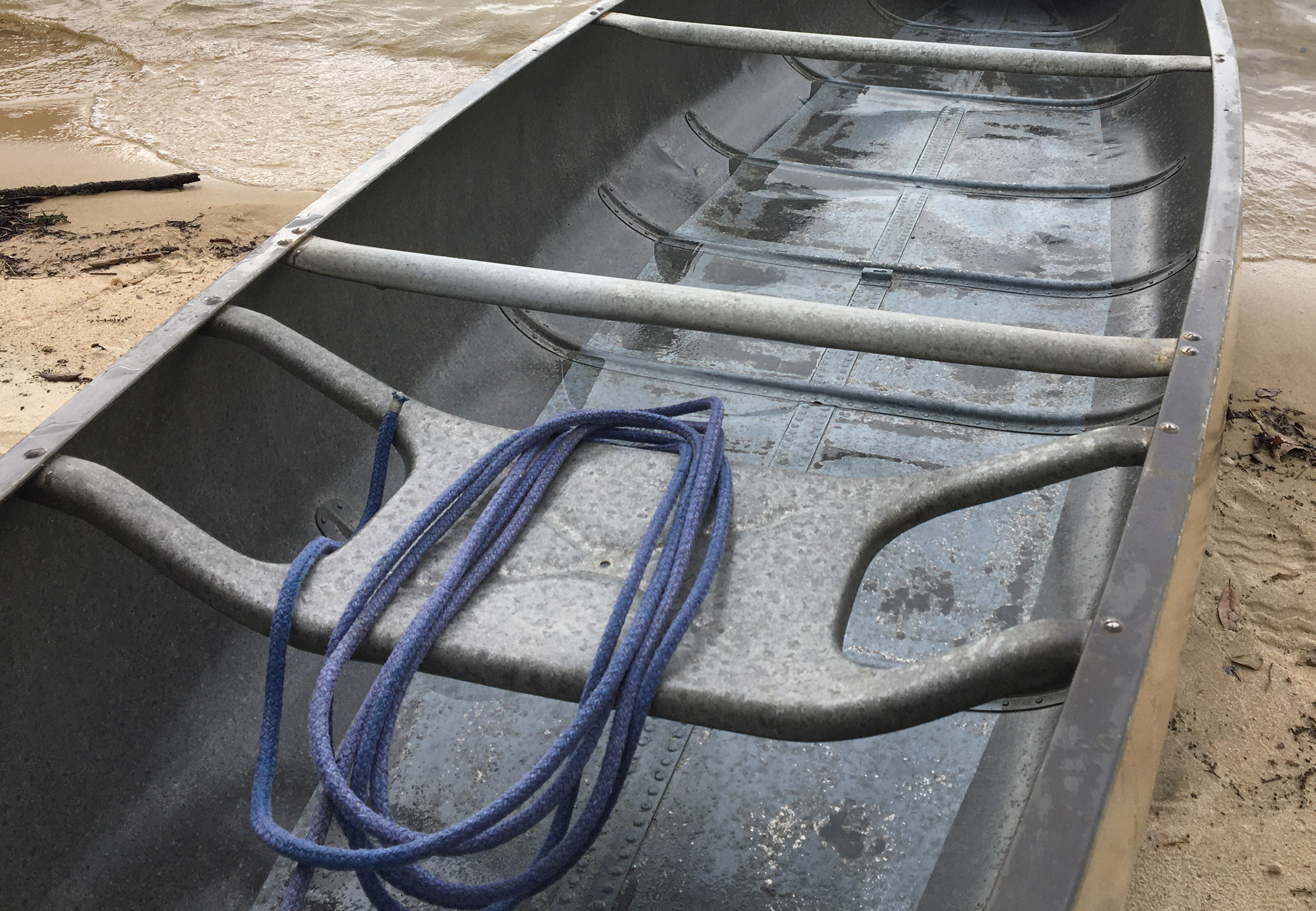

The stem caps are also heat-treated for strength, close-riveted with flush rivets to reduce drag below the waterline, as is the outer keelson. The solid extruded T-6 gunwales provide rigidity and are bolt-fastened to the thwarts. The current Marathon canoe capacity, subject to the more stringent requirements established in 1972, is a little lower at 755 lbs total (660 lbs people weight). Our 17′ Double-Ender has a rated carrying capacity of five people (weighing a total of up to 750 lbs) and 805 lbs total capacity. There is a small gap around the compartment edge that allows for ventilation and drainage, a great attribute because closed compartments often take in water and retain it.

These rolled plates also serve as covers for the flotation compartments, which are filled with closed-cell foam to keep the canoe afloat. The bow and stern caps have rolled edges that make comfortable handholds when dragging or carrying the canoe. Straps from the tow shackles down to the bumper are also advisable. The canoe thwarts to be secured to the side of the rack, in addition to two top straps. This provides better visibility for the driver. Secure the upside-down canoe over the passenger’s side.

The canoe trailers easily and can be singlehandedly cartopped by raising one end and then the other onto a roof rack. We found our latest Double-Ender on Craigslist in 2013. The newer Marathon boats have hulls that are 0.060″ thick and, as a result, weigh in at 81 lbs. The standard 17′ Double-Ender weighs 75 lbs and the Light Weight, 60 lbs. The Light Weight models had extra ribs to offset the thinner hull material. Grumman also offered a Light Weight model with hull thickness of 0.032″ for canoeists who did a lot of portaging. Our 17’ Double-Ender, built in the mid-1950s, is made from 0.051”-thick aluminum alloy. Note the tight spacing of the rivets along the keel. For whitewater use, a flatter keel with a lower 3/8″ profile, is available. The standard 17′ Double-Ender has a T-shaped keel that helps the canoe track straight and reduces leeway, which we can attest is very helpful on open water. The inner and outer extruded keels sandwich a neoprene gasket with the hull halves for a watertight seal flush rivet heads reduce drag. Templates are used to establish uniform spacing for the rivets. Close rivet spacing ensures maximum strength along the keel and ribs. The halves are joined to an extruded aluminum inner and outer keel, die-formed ribs, gunwales, stem and stern caps with T-6 Alumilite rivets that were specifically designed for the Grumman process. The canoes are handcrafted and begin with hull halves formed on a cold die press from an aluminum alloy sheet, then heat-hardened to a T-6 temper to increase mechanical strength and reduce the metal’s susceptibility to intergranular corrosion. The same tooling and jigs that were developed for postwar production of the canoes are still in use in Marathon. Grumman opened a second plant in Marathon, New York, in the 1950s, dedicated solely to construction of recreational watercraft, and it is still producing boats today. The canoes are made of the same high-strength and quality materials that their famous Navy fighter aircraft and seaplanes were made from, with the same exceptional levels of workmanship. The first canoe produced in 1945 was a 13-footer, and five more models followed by the end of the war. After the war, Grumman branched out into canoes and johnboats, with their first canoes coming out of the aircraft plant in Bethpage, New York. One of the company vice presidents, William Hoffman, after portaging a heavy wood-and-canvas canoe on a fishing trip, had the idea to make an aluminum canoe that would be 25 to 50 percent lighter. Grumman Aircraft Engineering Corporation was founded in 1929 and manufactured Navy fighter planes during World War II. The authors’ 17′ Double Ender sports a new paint job, on the outside and aside from the facelift, is as good as new more than 60 years after leaving the factory. We set out a few years back to find another Grumman 17′ Double-Ender we knew they were a good size for two to four people and some picnic snacks, and Grumman canoes have a well-deserved reputation for versatility and durability. That canoe was acquired in the mid-1960s and it is still around 55 years later, often resting on the shoreline of her brother’s pond in Southeast Texas. Audrey’s family always had a canoe either around the house, on top of the car, or splashing down into many lakes and ponds from Texas all the way up to Illinois.


 0 kommentar(er)
0 kommentar(er)
